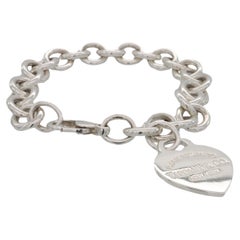Tiffany Blue Heart Tag Bracelet
Recent Sales
21st Century and Contemporary American Modern Link Bracelets
Sterling Silver
21st Century and Contemporary Charm Bracelets
18k Gold
21st Century and Contemporary American Contemporary Chain Bracelets
18k Gold, Yellow Gold
2010s American Modern Link Bracelets
Sterling Silver
20th Century Link Bracelets
Sterling Silver, Enamel
Tiffany & Co. for sale on 1stDibs
Tiffany & Co. is one of the most prominent purveyors of luxury goods in the United States, and has long been an important arbiter of style in the design of diamond engagement rings. A young Franklin Delano Roosevelt proposed to his future wife, Eleanor, with a Tiffany ring in 1904. Vanderbilts, Whitneys, Astors and members of the Russian imperial family all wore Tiffany & Co. jewels. And Jacqueline Kennedy Onassis preferred Tiffany china for state dinners at the White House.
Although synonymous with luxury today, the firm started out rather modestly. Charles Lewis Tiffany and John B. Young founded it in Connecticut as a “stationery and fancy goods emporium” in 1837, at a time when European imports still dominated the nascent American luxury market. In 1853, Charles Tiffany — who in 1845 had launched the company’s famed catalog, the Blue Book, and with it, the firm’s signature robin’s-egg blue, which he chose for the cover — shifted the focus to fine jewelry. In 1868, Tiffany & Co. gained international recognition when it became the first U.S. firm to win an award for excellence in silverware at the Exposition Universelle in Paris. From then on, it belonged to the pantheon of American luxury brands.
At the start of the Gilded Age, in 1870, Tiffany & Co. opened its flagship store, described as a "palace of jewels" by the New York Times, at 15 Union Square West in Manhattan. Throughout this period, its designs for silver tableware, ceremonial silver, flatware and jewelry were highly sought-after indicators of status and taste. They also won the firm numerous accolades, including the grand prize for silverware at the Paris Exposition of 1878. Among the firm’s glittering creations from this time are masterworks of Art Nouveau jewelry, such as this delicate aquamarine necklace and this lavish plique-à-jour peridot and gold necklace, both circa 1900.
When Charles Lewis Tiffany died, in 1902, his son Louis Comfort Tiffany became the firm’s design director. Under his leadership, the Tiffany silver studio was a de facto design school for apprentice silversmiths, who worked alongside head artisan Edward C. Moore. The firm produced distinctive objects inspired by Japanese art and design, North American plants and flowers, and Native American patterns and crafts, adding aesthetic diversity to Tiffany & Co.’s distinguished repertoire.
Tiffany is also closely associated with diamonds, even lending its name to one particularly rare and exceptional yellow stone. The firm bought the Tiffany diamond in its raw state from the Kimberley mines of South Africa in 1878. Cut to create a 128.54-carat gem with an unprecedented 82 facets, it is one of the most spectacular examples of a yellow diamond in the world. In a broader sense, Tiffany & Co. helped put diamonds on the map in 1886 by introducing the American marketplace to the solitaire diamond design, which is still among the most popular engagement-ring styles. The trademark Tiffany® Setting raises the stone above the band on six prongs, allowing its facets to catch the light. A lovely recent example is this circa-2000 platinum engagement ring. Displaying a different design and aesthetic (but equally chic) is this exquisite diamond and ruby ring from the 1930s.
Finding the Right charm-bracelets for You
Vintage charm bracelets are a no-brainer when it comes to accessorizing. The charm bracelet, as a distinctive and personal finishing touch, has been around for a long time.
An iconic fashion statement, the charm bracelet has changed considerably throughout human history, but it has always been imbued with deep personal meaning. Jewelry in general has held intimate significance for us for thousands of years. Nearly every Egyptian, rich or poor, took jewelry seriously and was buried with some kind of jewels, and, later, jewelry of the Hellenistic era was passed down between generations as family heirlooms.
As children, we played with the antique and vintage bracelets that populated the jewelry boxes in our family homes, hearing them jingle and jangle while we learned the story of each charm. If we were lucky, some of our favorite charm bracelets were passed down to us as keepsakes.
Charm bracelets quickly became an extremely popular piece of jewelry in the 19th century. The Victorian penchant for symbolic jewelry lent itself perfectly to charm bracelets. Queen Victoria popularized charm bracelets among European nobility, as she was incredibly enthusiastic about giving them as gifts. Their popularity continued through her reign and into the 1900s. Tiffany & Co. introduced its iconic charm bracelet in 1889, and, since then, our love for this accessory has only broadened.
Modern charm bracelets feature a variety of charms and are made from a range of materials. And just as they did thousands of years ago, each charm on a charm bracelet today holds unique significance for the wearer and tells a piece of their story.
On 1stDibs, find a collection of charm bracelets designed by Cartier, Van Cleef & Arpels, David Webb, Paul Flato and more.
- 1stDibs ExpertAugust 17, 2021A Tiffany & Co. engagement ring can cost as little as $13,000 or as much as $500,000 depending on the center stone’s carat weight, the band material and whether or not there are any side stones. The smaller the stone, the cheaper the ring will be. Find engagement rings designed by Tiffany & Co. on 1stDibs.

